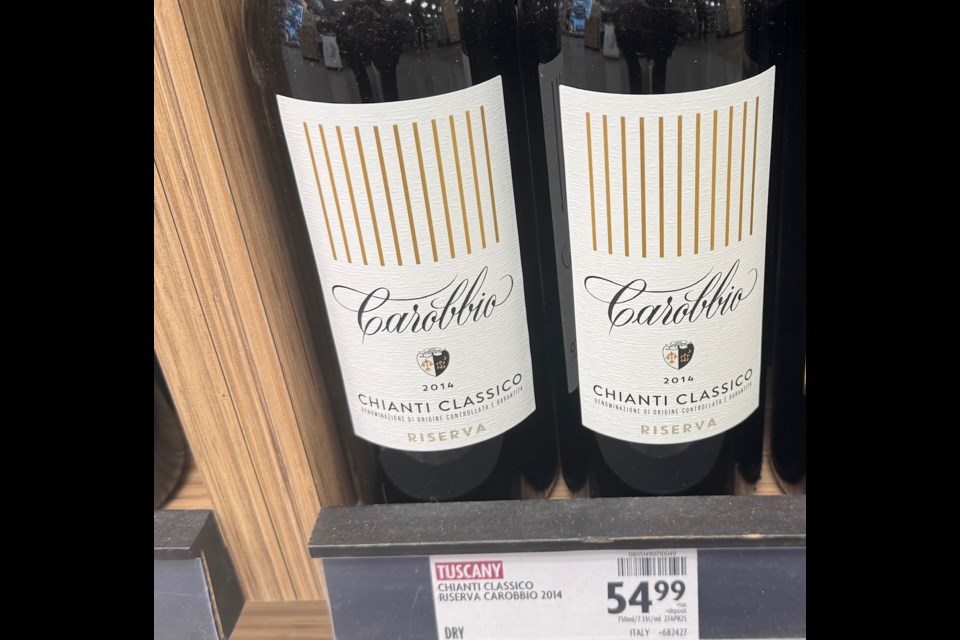Chianti Classico is a famous wine region in Tuscany, Italy, that dates back to the 14th century and was delineated in 1716.
In 1932, due to the popularity of Chianti wines worldwide, the original boundaries of Chianti were expanded, and the original Chianti location was named a sub-region in Chianti called Chianti Classico.
Historically, to be able to label a Chianti wine, a wine needed to be made using at least 70-per-cent Sangiovese grapes in the wine. The other 30 per cent of the grapes used to produce a Chianti wine could be a wide variety of grape varietals, including varietals used to produce white wines.
Due to a number of factors, including the growing popularity of Chianti wines worldwide, an economic downturn in the late 19th century and disease that killed many original vines in Chianti, some producers started to plant higher-yielding but lower quality grape varietals to make Chianti wines.
This led to the mass production of Chianti wines that were known more for their affordable price than for the quality of the wines.
Some producers, like Antinori, were not happy with just producing high-volume value wines that did not show the unique qualities of the Chianti region.
They started to produce wines that did not follow the Chianti rules, and as such, these wines could not be labelled as Chianti wines.
These wines became known as IGT (Indicazione Geografica Tipica) wines. But because some of these wines were so high quality and commanded such a high price that they became known as Super Tuscan wines.
The Chianti Classico Consortium was instrumental in bringing Chianti Classico back to the forefront of this wine region.
The consortium updated the standards so that Chianti wines now need to use a minimum of 80-per-cent Sangiovese grapes in the wine.
In addition, the remaining 20 per cent of the grapes must be authorized grape varietals that are only used to produce red wines. Many of the high-yielding, lower-quality grape varietals used to produce Chianti in the past are no longer allowed to be used.
The consortium also funded extensive research into the viticultural and winemaking practices of the Chianti Classico area and assisted with replanting more than 50 per cent of the vineyards in the Chianti Classico subregion with improved Sangiovese clones since the 1980s.
Historically, there were three levels of Chianti Classico wines. All Chianti Classico wines must be aged for at least six months before release.
Chianti Classico Annata wines are aged for a minimum of one year, while Chianti Classico Riserva wines must be aged for at least 24 months, including at least three months in bottle before release.
In 2014, the consortium introduced a new quality level of Chianti Classico: Chianti Classico Gran Selezione.
Chianti Classico Gran Selezione is made exclusively from a winery's own grapes and must be aged a minimum of 30 months before release, of which three months must be in bottle.
Although some riserva wines already met this standard before 2014, the creation of the Gran Selezione designation encouraged producers to increase the quality of their wines by using stricter standards and giving these wines recognition for using such high standards.
Only about five per cent of all Chianti Classic wines reach the Gran Selezione standard.
The consortium announced in July 2023 that starting with the 2027 vintage, 90 per cent of all grapes used in a Chianti Classico Gran Selezione wine must be estate-grown Sangiovese grapes.
In addition, they are further limiting the other 10 per cent of grapes used in the wine to eight indigenous grape varieties of the Chianti region.
Each Gran Selezione wine may also identify itself if all the grapes are grown in one of the 11 newly created UGAs (Unità Geografiche Aggiuntive, or Additional Geographical Units) districts. This will allow Gran Selezione wines to be distinguished by their identity and territoriality.
Does this mean Gran Selezione wines are better than Chianti Classico Annata or Riserva wines?
Not necessarily, since everyone has their own taste preference and budget for what they want to spend on a wine.
By increasing the standards and allowing specialized labelling for those who meet stricter standards, this will only encourage producers to make higher quality and more distinctive wines that are indicative of the UGAs where the wine is produced.
Chianti Classico Gran Selezione wines with the new UGA districts will provide exceptional value for a top-shelf wine, at least until the consumers discover how undervalued Chianti Classico wines have become. So it is time to revisit the Chianti Classico region!
My top Chianti Classico picks are the Carobbio 2014 Chianti Classico Riserva ($54.99) and the Castello di Ama 2018 Chianti Classico Gran Selezione ($64.99). For more information about Chianti Classico and their new UGA districts, see here.
Until next time, happy drinking!
Tony Kwan is a Richmond News columnist. Lawyer by day, and a food and wine lover by night. Kwan is an epicurean who writes about wine, food and enjoying all that life has to offer.
📣 Got an opinion on this story or any others in Richmond? Send us a letter or email your thoughts or story tips to [email protected].
📲 To stay updated on Richmond news, sign up for our daily headline newsletter.
💬 Words missing in article? Your adblocker might be preventing hyperlinked text from appearing.



